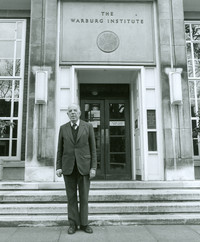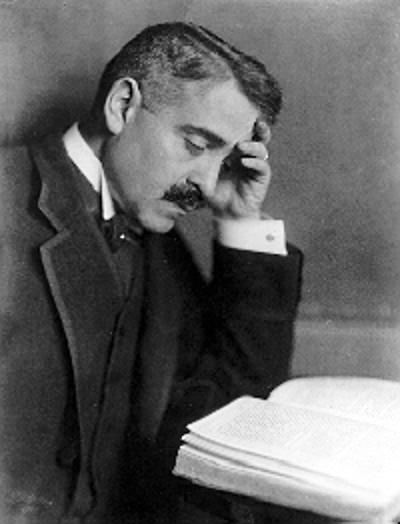Much of Britain’s industry has disappeared. The recently vaunted financial sector is in disarray. But British universities remain world leaders. The conditions that have made this possible included, in the past, a loose, egalitarian organization, substantial autonomy for scholars and teachers, and a generous esprit de corps. Yet instead of preserving this distinguished and successful sector of British life, both Labour and Tory governments seem bent on rearing hierarchies, crushing autonomy, and destroying morale. The idea, apparently, is to reconfigure the universities on a corporate model—not, however, the democratic model used by Google and other corporations that are flourishing now, but the older one of the 1950s, which did wonders for such British industries as shipbuilding and car manufacturing.
Particularly painful is the University of London’s attempt to disperse the unparalleled collections of the Warburg Institute. Named for a supremely imaginative historian of art and culture, Aby Warburg, the institute began as his library in Hamburg, which was devoted to the study of the impact of classical antiquity on European civilization. The library was rescued from Hamburg in 1933, following Hitler’s rise to power, thanks in part to the help of British benefactors. In the midst of World War II, Rab Butler, president of the British Board of Education, decided that the institute must be kept in Britain, and that the only way to do this was to make it part of the University of London, which was in those days a great force for openness and innovation in British higher education.
In the age of austerity that followed the Blitz, the University of London saw Warburg’s library as a jewel to be cherished. An ugly but efficient home for the institute was built in Bloomsbury, and for decades the university took pride in supporting its work. In the new age of austerity, by contrast, the university, which now controls the funds once earmarked for the institute, is doing its best to destroy what it once helped to save. In 2007, like a Dickensian villain, the university began self-parodically demanding enormous “economic” space charges for the Warburg’s building—charges so large that the institute cannot possibly pay them. The only way for the institute to avoid these charges would be to move into much smaller premises and close its stacks, a decision that would destroy its essential character.
At the heart of the Warburg Institute is its library of 350,000 volumes. The collection is not enormous when compared to the world’s great research libraries. But the quality of the library’s holdings is extraordinary—some 40 percent of the books on its shelves are not in the British Library. Except for the rarest of them—now being digitized and made universally available—the books are made accessible to readers as Warburg intended, on open shelves (itself unusual in Europe). They are organized, moreover, by a particular system of classification, which originated with Warburg himself.
The library is designed not simply to make information rapidly accessible—as a search engine might—but to shape and channel scholarly investigations. Any sustained trip into the Warburg stacks will bring the reader not only to the books he or she is looking for, but also to their unexpected “good neighbors.” Magic and science, religion and philosophy, Christianity and Judaism appear in close proximity—and challenge the reader both to trace webs of unexpected connections and to find the points of radical disjunction. Look for the history of astronomy and you will find primary and secondary sources, learned treatises and popular almanacs—texts, tables, and images that range in origin from the ancient Near East to the present—and the vast literature of astronomy’s unruly sister discipline, astrology, as well. On the shelves of the institute, the reader experiences the coincidence of opposites.
In Germany in the years after World War I the Warburg library helped to shape the thought and work of some of the greatest scholars of the first half of the twentieth century, from Erwin Panofsky to Ernst Cassirer. Since it became part of the University of London, the Warburg Institute has offered a home for scholars of profound and original scholarship—both members of the staff, such as Michael Baxandall, Ernst Gombrich, Charles Schmitt, D.P. Walker, Rudolf Wittkower, Frances Yates, and others who made it their home away from home, such as Arnaldo Momigliano, Marjorie Reeves, and Gershom Scholem.
Generations of students have passed through the institute’s graduate programs and put its stamp on fields ranging from the classics and Near Eastern Studies to the histories of art and science. Staff, students, and outside allies have filled the distinguished journal that the Warburg produces in collaboration with the Courtauld Institute and the several series of books that it publishes with innovative studies of every aspect of the classical tradition—seen, as it should be, not as a single set of texts crafted by Greeks and inherited by the followers of Leo Strauss, but as a great Mississippi of texts, ideas, images, and objects, constantly intersecting with and transformed by other streams.
Advertisement
A visionary scholar, Aby Warburg was obsessed with cultural exchanges of all kinds and in all periods, and tinkered throughout his life with new ways to frame and display visual images, in order to reveal their interconnected meanings across time and space (he saw the vital importance of moving images, for example, long before most scholars). His unconventional tool for studying this shifting web of historical relationships was a picture atlas that remained in perpetual flux, and to which he gave the name Mnemosyne, or memory. (The project was unfinished when he died in 1929 and never published, though scholars have attempted to reconstruct versions of it.) For Warburg, cultural memory involved more than the stale invocation of tradition; it demanded heroic struggles with the forces of historical oblivion. In light of Warburg’s legacy, current threats to his institute’s very existence would apparently confirm Marx’s adage that great events happen twice, “once as tragedy, and again as farce.” It seems brutally ironic that the core of Warburg’s legacy is now under threat from the very university that helped ensure its survival.
If the university’s plans succeed, the institute will now have to abandon Warburg’s fundamental principles, lose control of its own books and periodicals (many of them acquired by gift or by the expenditure of the institute’s endowments), and shed, over time, the distinguished staff of scholars and scholar-librarians who train its students and continue to shape its holdings. The Warburg’s collections will become a component of the troubled library system of the University of London—a system that has already shown its willingness to sell off thousands of valuable books, and could do the same with part of the Warburg’s holdings, should it continue, as is likely, to find itself in financial straits. A center of European culture and a repository of the Western tradition that escaped Hitler and survived the Blitz may finally be destroyed by British bean-counters. It is a picture, in the words of H.L. Mencken, “to bemuse the vulgar and to give the judicious grief.”
Recent articles in the German and Swiss press have called attention to the Warburg’s travails. If the University of London insists on following through with its plan, perhaps the German authorities can find the means to bring the Warburg back to its original home. That would certainly be preferable to watching as philistines demolish a great European institution.
A longer version of this article will appear in the September 30 issue of The New York Review.





